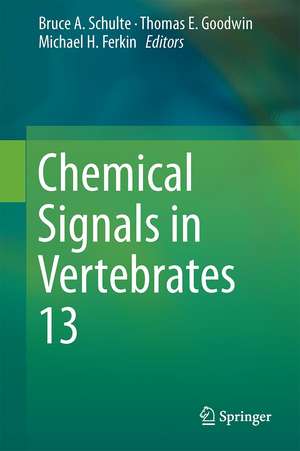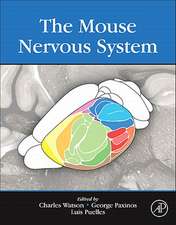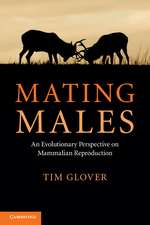Chemical Signals in Vertebrates 13
Editat de Bruce A. Schulte, Thomas E. Goodwin, Michael H. Ferkinen Limba Engleză Hardback – 10 dec 2015
| Toate formatele și edițiile | Preț | Express |
|---|---|---|
| Paperback (1) | 1207.35 lei 38-44 zile | |
| Springer International Publishing – 30 mar 2019 | 1207.35 lei 38-44 zile | |
| Hardback (1) | 1407.64 lei 3-5 săpt. | |
| Springer International Publishing – 10 dec 2015 | 1407.64 lei 3-5 săpt. |
Preț: 1407.64 lei
Preț vechi: 1716.63 lei
-18% Nou
Puncte Express: 2111
Preț estimativ în valută:
269.34€ • 281.98$ • 222.87£
269.34€ • 281.98$ • 222.87£
Carte disponibilă
Livrare economică 15-29 martie
Preluare comenzi: 021 569.72.76
Specificații
ISBN-13: 9783319220253
ISBN-10: 331922025X
Pagini: 536
Ilustrații: XXII, 536 p. 77 illus., 17 illus. in color.
Dimensiuni: 155 x 235 x 36 mm
Greutate: 1.21 kg
Ediția:1st ed. 2016
Editura: Springer International Publishing
Colecția Springer
Locul publicării:Cham, Switzerland
ISBN-10: 331922025X
Pagini: 536
Ilustrații: XXII, 536 p. 77 illus., 17 illus. in color.
Dimensiuni: 155 x 235 x 36 mm
Greutate: 1.21 kg
Ediția:1st ed. 2016
Editura: Springer International Publishing
Colecția Springer
Locul publicării:Cham, Switzerland
Public țintă
ResearchCuprins
Are Mammals Just Furry Bugs with Fewer Legs? Convergences in Mammalian and Insect Chemical Ecology.- Chemical Signals in Vertebrates 13: Where We Stand and What Might Be Next.- Assessing the Role of Olfactory Cues in the Early Life History of Coral Reef Fish: Current Methods and Future Directions.- A Small Exposé on Bovine Pheromones - with Special Reference to Modifications of the Reproductive Cycle.- Coding of Group Odor in the Subcaudal Gland Secretion of the European Badger Meles meles: Chemical Composition and Pouch Microbiota.- The Role of Bacteria in Chemical Signals of Elephant Musth: Proximate Causes and Biochemical Pathways.- Age-related Variation in the Scent Pouch Bacterial Communities of Striped Hyenas (Hyaena hyaena).- Bacterial Communities Associated with Junco Preen Glands: Preliminary Ramifications for Chemical Signaling.- Age-Related Effects on Individual Discrimination among Meadow Voles, Microtus pennsylvanicus.- Putative Pheromone of the Indian Crestless Porcupine, Hystrix brachyuran.- Chemical Cues, Hibernation and Reproduction in Female Short-Beaked Echidnas (Tachyglossus aculeatus setosus): Implications for Sexual Conflict.- Chemical Analyses Reveal Family Specific Nest Odor Profiles in Zebra Finches (Taeniopygia guttata): A Pilot Study.- Exploring the Use of Olfactory Cues in Non-Social Context in Zebra Finches (Taeniopygia guttata).- Variation in Urinary Amino Acids in the Mozambique Tilapia: A Potential Signal of Dominance or Individuality?.- A Low Phytoestrogen Diet Reduces the Proceptivity but not the Attractivity of Meadow Voles (Microtus pennsylvanicus).- Chemical communication in Indian Blackbuck (Antelope cervicapra L) with Special Reference to Dominance.- Asian Elephant Reflections: Chirality Counts.- Detection of Fish and Newt Kairomones by Ovipositing Mosquitoes.- Evolutionary Aspects of the Use of Predator Odors in Antipredator Behaviors of Lumholtz’s Tree-kangaroos (Dendrolagus lumholtzi).- Small Emissions with Major Consequences: Specialized Malodorous Defenses in Birds.- A Review of Chemical Defense in Poison Frogs (Dendrobatidae): Ecology, Pharmacokinetics and Autoresistance.- Semiochemicals in Anurans: Testing different Categories with one Poison Frog Species.- Chemical Communication in Archaic New Zealand Frogs.- Chemical Signals in Giant Panda Urine (Ailuropoda melanoleuca).- Semiochemical Communication in Dogs in the Context of Reproductive Behavior.- Hormonal and Behavioral Responses to Odor Cues in Zoo-housed African Painted Dogs (Lycaon pictus).- Responses to Domestic Cat Chemical Signals in the House Mouse are Modulated by Early Olfactory Experience.- Does Deconvolution Help to Disentangle the Complexities of Mammal Odors?.- Guidelines for Collecting and Extracting Avian Odors in a Remote Field: Case Study of a Subantarctic Seabird.- Pair-specific Scents in African Wild Dogs, Lycaon pictus, and an Example of a Potential Method to Identify Signals within Complex Mixtures.- Automated headspace solid-phase microextraction of urinary VOCs from eleven maned wolves (Chrysocyon brachyurus): a recursive workflow for GC-MS analysis.- Learning and Applications of Chemical Signals in Vertebrates for Human-Wildlife Conflict Mitigation.- An Experimental Test of the Effect of Diet on Preen Wax Composition in New Zealand Silvereyes (Zosterops lateralis).
Recenzii
Notă biografică
Dr. Bruce A. Schulte is a Professor and the Department Head of Biology at Western Kentucky University.
Dr. Thomas E. Goodwin is the Elbert L. Fausett Distinguished Professor of Chemistry at Hendrix College.
Dr. Michael H. Ferkin is the Jack H. Morris Distinguished Professor of Biological Sciences at the University of Memphis.
Textul de pe ultima copertă
The thirteenth volume of Chemical Signals in Vertebrates (CSiV) emanates from the first joint meeting of CSiV and the International Society of Chemical Ecology (ISCE), which was held at the University of Illinois Urbana-Champaign in June 2014. Chemicals involved in communication in both mammals and insects are by and large secondary metabolites—that is, they are generally not molecules involved in the primary physiological processes of life, such as respiration, digestion, excretion, and in the case of green plants, photosynthesis.
Caracteristici
Covers a broad array of topics including Chemical Ecology of Social Behavior; Chemical Signals – Analysis and Synthesis; Evolution, Genomics, and Transcriptomics of Chemical Signals; Molecular Mechanisms of Semiochemical Perception and Processing; Multimodal Communication; Neuroethology and Neurophysiology Contains the latest research on chemical communication relevant to vertebrates Examines the impact of technology on the study and science of chemical ecology









